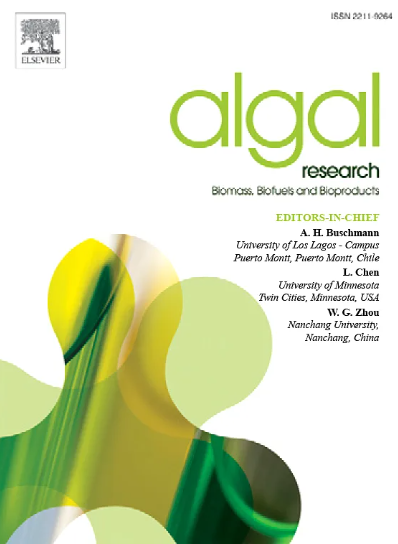Assessing Target of Rapamycin (TOR) activity in the diatom Phaeodactylum tricornutum using commercially available materials
IF 4.6
2区 生物学
Q1 BIOTECHNOLOGY & APPLIED MICROBIOLOGY
Algal Research-Biomass Biofuels and Bioproducts
Pub Date : 2024-10-11
DOI:10.1016/j.algal.2024.103746
引用次数: 0
Abstract
Target of rapamycin (TOR) is a conserved protein kinase that regulates the balance between catabolic and anabolic processes in response to nutrient availability. Although the central role of TOR kinase in nutrient stress responses is well-recognized, little is known about the molecular basis of TOR signaling in ecologically important secondary algae with plastids of red algal origin, such as diatoms, as assessing in vivo TOR kinase activity is a difficult task. To assess TOR kinase activity, the phosphorylation status of downstream components, such as ribosomal protein S6 (RPS6), must be measured. Unlike for model organisms, an antibody that detects phosphorylated (P-) RPS6 in diatoms is not commercially available. Therefore, we developed a convenient method in which P-RPS6 and non-P-RPS6 were detected via Phos-tag affinity electrophoresis and immunoblotting with a commercial antibody that cross-reacts with RPS6 (both P- and non-P-RPS6) in the diatom, Phaeodactylum tricornutum. Using this Phos-tag-based method, we observed a dose-dependent decrease in the P-RPS6/total RPS6 ratio in P. tricornutum cells treated with the TOR kinase inhibitor, AZD-8055. We also observed a reduction in the P-RPS6/total RPS6 ratio during the nitrogen-deficient culture of P. tricornutum, which indicated the inactivation of TOR kinase in response to nitrogen deficiency. Finally, we demonstrated the potential application of the Phos-tag-based method to other ecologically, evolutionarily, and industrially important secondary algae, such as Nannochloropsis oceanica (Stramenopiles), the haptophyte Tisochrysis lutea, and Euglena gracilis (Euglenid). As all experimental materials are commercially available, the Phos-tag-based method can be used to promote studies on TOR in diverse algae in different contexts.
利用市售材料评估硅藻 Phaeodactylum tricornutum 的雷帕霉素靶(TOR)活性
雷帕霉素靶蛋白激酶(TOR)是一种保守的蛋白激酶,可调节营养物质供应情况下分解代谢和合成代谢过程之间的平衡。尽管 TOR 激酶在营养应激反应中的核心作用已得到广泛认可,但人们对硅藻等具有重要生态意义的红藻质体次生藻类中 TOR 信号转导的分子基础知之甚少,因为评估体内 TOR 激酶活性是一项艰巨的任务。要评估 TOR 激酶的活性,必须测量核糖体蛋白 S6(RPS6)等下游成分的磷酸化状态。与模式生物不同,在硅藻中检测磷酸化(P-)RPS6 的抗体还没有商业化。因此,我们开发了一种简便的方法,通过 Phos-tag 亲和电泳和免疫印迹法检测硅藻 Phaeodactylum tricornutum 中的 P-RPS6 和非 P-RPS6。使用这种基于 Phos-tag 的方法,我们观察到在使用 TOR 激酶抑制剂 AZD-8055 处理的三棘藻细胞中,P-RPS6/总 RPS6 比率呈剂量依赖性下降。我们还观察到,在缺氮培养过程中,P-RPS6/总 RPS6 比率降低,这表明 TOR 激酶在缺氮情况下失活。最后,我们展示了基于 Phos-tag 的方法在其他生态、进化和工业上重要的次生藻类中的潜在应用,如 Nannochloropsis oceanica(Stramenopiles)、Tisochrysis lutea 和 Euglena gracilis(Euglenid)。由于所有实验材料都可从市场上买到,因此基于 Phos-tag 的方法可用于促进在不同环境下对不同藻类的 TOR 进行研究。
本文章由计算机程序翻译,如有差异,请以英文原文为准。
求助全文
约1分钟内获得全文
求助全文
来源期刊

Algal Research-Biomass Biofuels and Bioproducts
BIOTECHNOLOGY & APPLIED MICROBIOLOGY-
CiteScore
9.40
自引率
7.80%
发文量
332
期刊介绍:
Algal Research is an international phycology journal covering all areas of emerging technologies in algae biology, biomass production, cultivation, harvesting, extraction, bioproducts, biorefinery, engineering, and econometrics. Algae is defined to include cyanobacteria, microalgae, and protists and symbionts of interest in biotechnology. The journal publishes original research and reviews for the following scope: algal biology, including but not exclusive to: phylogeny, biodiversity, molecular traits, metabolic regulation, and genetic engineering, algal cultivation, e.g. phototrophic systems, heterotrophic systems, and mixotrophic systems, algal harvesting and extraction systems, biotechnology to convert algal biomass and components into biofuels and bioproducts, e.g., nutraceuticals, pharmaceuticals, animal feed, plastics, etc. algal products and their economic assessment
 求助内容:
求助内容: 应助结果提醒方式:
应助结果提醒方式:


